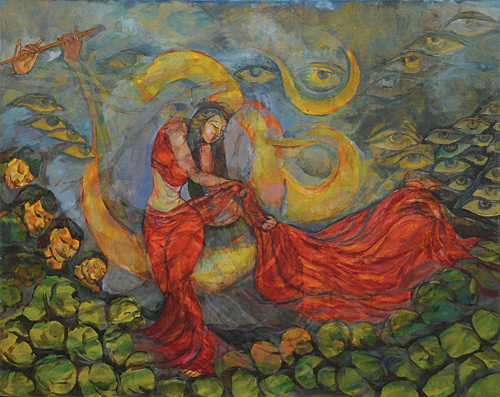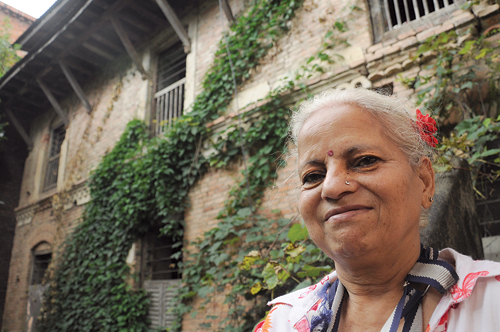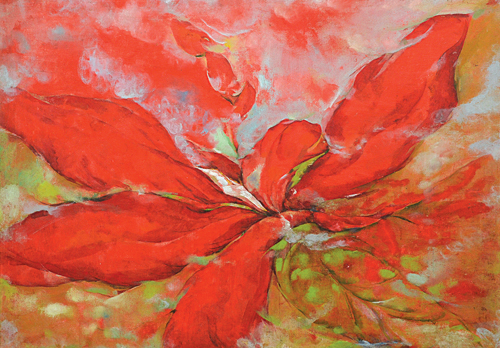I wind my way through the madly overgrown garden and reach the secluded studio standing at one corner, away from the main mansion. A faded collage of three women stares back at me from the door, a key to the world that is Shashikala Tiwari’s mind space – it has the artist’s young niece, Shashikala herself from an earlier time and the image of a Kumari. She laughingly calls it The Three Kumaris.
I knock and the door opens to reveal the smiling face of Shashikala. But her arm is in a sling, “I tripped over one of my dogs and the right wrist got fractured – happened only last week,” she clarifies, then quickly dispels my fear that she may not ever paint again by picking up a brush with her left hand – she is a painter and assiduously sticks to this mode of artistic expression, oil on canvas being her media of choice. “I can paint with my left hand too, if I need to,” says Shashikala, and begins to dab away at the canvas tilted on the easel, “…and the doctor says my right hand will be as good as new within the next two months.” Among a rare clutch of Nepal’s woman artists with a continuous history of practice, Shashikala is remarkable for her consistent output and spitfire spirit. She, however, defies the contemporary art world’s demands by insisting that her work be judged for aesthetic appeal alone and not on how or whether it addresses gender issues or political concerns – somewhat bewildering given the fact that she is considered a role model by many cotemporary women artists in the country today.

The afternoon sun is filtering in through a canopy of foliage and through the window – it ripples across her workspace strewn with books, tubes of paint and old brushes. Large canvases stand stacked at one end of the room, a few hanging at odd angles on the walls. What a treasure trove! – for Shashikala is reclusive to the point of having turned into a myth. Her last solo show was held more than ten years ago. “I am a simple person and I prefer to work on my own instead of going out,” confides Shashikala as she begins to set out the canvases with my help.

Content (1982) is one of the few early works still with her – from a series on relationships called Echo of Love shown as a solo in 1982 at the Nepal Art Council. The figures of a man and a woman fracture and collide to build up a rocky landscape, while simultaneously becoming one with it. This is a theme that runs through many of her works, the interconnections between nature and the human world as she strongly puts forth, “You can see human forms in nature. Human beings are part of nature – they blend together!” No wonder her flowers and leaves, each throbbing with vitality and an incandescent light, slip into the realm of morphological metaphors that subliminally explores feminine sexuality – of which Yellow Poinsettia (2000), Rippled Orchid (2006), Just After a Hailstorm (2010) and Youth (1997) are excellent examples – and occasionally bring to mind a whiff of Georgia O’Keeffe.

Born into a family of architects and doctors, Shashikala’s beginnings were with random doodles in school textbooks followed by a rare few weekly sessions with the maestro, Chandra Man Maskey, and finally thanks to her father’s support – artschooling at MS Baroda in India. But by the time she reached Baroda, she had already developed a style of her own, which she had arrived at by herself – unaided and uninfluenced. “You are not a flat surface – there are so many dimensions to things,” was her cryptic comment when asked about the swirling, tumultuous strokes that build up her images in which strength and chaos often surround and contort the animate and the inanimate equally – be it women as in Merging with Nature or Turmoil (1991) or mountainscapes and stormy skies. Almost all her human figures tend to melt into natural backgrounds as their contours blur – giving us a glimpse into a strangely energized space that questions the nature of reality per se.

When I first visited her studio a few months ago, a blank white canvas stood on her easel – inscribed with faint brush marks. Over the next few weeks the canvas took on a life of its own, yielding yet another vision of the quintessential devotee Meera and Meera’s divine beloved, Lord Krishna and is now called Mein Teri Piya – a trope she started exploring in 2005 and that continues to capture her imagination even to this day. Pieces like Devotion (2005) reinforce her preoccupation with strong feminine figures, often drawn from history or myths – be it Meera, Radha or Draupadi – or sometimes just a lone woman lost in thought (Lady Thinking, 1988) or dancing with great abandon (Paradise, 1987; Skipping the Rainbow, 1988 and Amrapali, 1984).

This heady abandon is infectious, though double-edged. On one level they are exuberant in their own skin, oblivious to the restrictive agenda of the male gaze. On another, they seem to be self-consciously reinforcing gender biases through their own physicality – the ‘ideal’ feminine form that is slim waisted, voluptuous and traditionally garbed. The reiteration of such an ideal is no doubt a throwback upon regional artistic conventions but when found in such viciously critical pieces as Panchali (1990), does raise questions about the artist’s intentions. In Panchali she depicts Draupadi/Panchali at the moment of public disrobing in a royal court as her husbands and male relations stand mute and helpless like cabbages.
Lord Krishna, an outsider, saves the day. Perhaps Shashikala is using the so-called feminine ideal and the visual language that supports its perpetuation by using the insidious tool of reiteration? Perhaps it is a conscious strategy adopted by her to question the same? It may indeed be worthwhile to look at whether and “how women producers developed alternative models for negotiating modernity and the spaces of femininity”1 in the context of Nepal – through Shashikala’s oeuvre.
The artist is not averse to creating more directly topical pieces like the deviant Freedom (1990) that depicts two women riding a motorbike into the future – a rare moment when she allows the political dreams of the time to invade her pictorial space. Or with the Kumari in a halterneck top, in which Shashikala cheekily questions how the tradition takes its toll on living women.
But she is no male-hater either – Krishna happens to be a favourite with Shashikala, almost always present in her pieces as a vibrant peacock, sometimes representing the divine male energy. Examples include Meera in Desert (2011), Bhakti Series (2011), Meera in Purple (2012) and of course the latest in green. “Almost all my paintings have a man in them, it’s just that he kind of disappears next to the woman’s strength,” shares Shashikala, smiling.
Instead of restricting herself to an idiom, Shashikala has been quick to experiment often in the past. For example, the Footmarks of Peace series (1984) shown at NAFA had her visualizing the life of the Buddha. Not surprisingly, the lines and surfaces are much tamer here, at one with the theme of enlightenment and peace. In Enlightenment she captures the exact but very private moment when Siddhartha became the Buddha – his back is turned our way as he looks away and across dimensions (Enlightenment, 1984). But the peace shatters for us lesser mortals soon and the tumult returns with a fury across her mountainscapes (Peace Shattered). One of the reasons she found the world of the Buddha so exciting to explore, was the enlightened one’s vital connection to nature – the forest and the open skies that cradled his passage through light. “I will put in a window to show a mountain if a painting does not allow me any other way of connecting to nature,” says Shashikala.
With more than ten prestigious national and international solos and numerous group shows to her credit, Shashikala’s last in Nepal was at the Nepal Art Council in which she paid tribute to the royals who lost their lives in the massacre of 2002. Also known as the From the Void: Bewildered Eyes (2002) series, it was not only an expression of her bewilderment with the apocalyptic events but also a certain coming to terms with her own personal losses, especially that of her father, whom she lost to a heart attack. “I realized what void is. We avoid the void every second but there it is, a part of our lives every day,” shares Shashikala.
Incidentally, Shashikala also helped build up Nepal’s premiere art gallery – the Siddhartha Art Gallery – in its initial stages with Founder-Director Sangeeta Thapa. An accomplished poet as well, she is misleading in her humility as she admits to being lazy. She has exhibited widely – in Bangladesh, Germany, India, Japan, Korea, Malaysia and United Kingdom. Unlike many others, she usually concentrates on a single piece and gives it the time it needs to reach completion. Her idea is usually drafted beforehand and she waits for it to acquire materialization through canvas and paint. An incessant creator, she will resume painting and reading as soon as she wakes up, sometimes as early as three in the morning!
Light and its reflections and refractions form the core of her vision. As it bounces off surfaces through a virtuosic layering of paint, it strangely resonates of her favourite artists – the Fauves, and Van Gogh. As I have said elsewhere, “(Her) shadows are obstinate presences that break up the light, pushing darkness into the realm of color. Tiwari’s shadows occupy space rather than descend into nothingness. She steals along the edges of language with her light, trying to capture realities that elude rational understanding.”
We are indeed lucky that Shashikala is about to start work on a new series – based on either of two classic Sanskrit love poems – Meghaduta (5th century CE) by Kalidasa and the later cycle of lyrics, Gitagovinda (12th century CE) by Jayadeva. Both will take forward her fascination with the interplay between the spiritual and the emotional while exposing us to the brilliance of her brush!
Griselda Pollock, Modernity and the Spaces of Femininity in Vision and Difference: Femininity, Feminism and the Histories of Art, London, 1988










